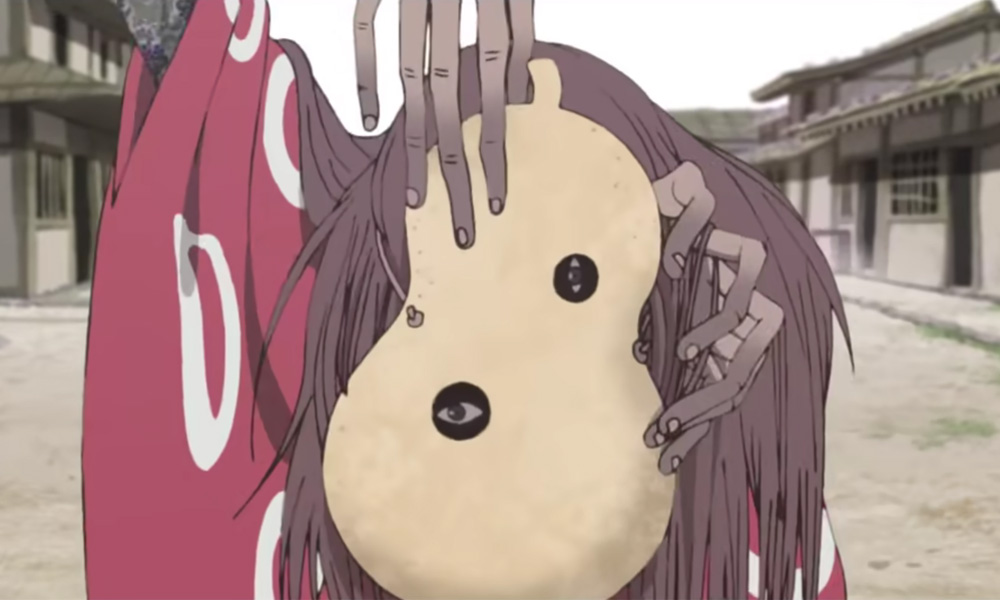With infectious animation and visual vibrancy, Masaaki Yuasa once again proves himself a master of his craft in Inu-Oh. Based on the novel Tales of the Heike: INU-OH by Hideo Furukawa, Yuasa casts his kinetic, relentless vision on 14th century Japan in a rock-opera anime about the significance of remembering where we come from and what led us to where we are, in a timeless work set in history.
Despite outlandish designs and the accentuated style that’s appeared in all of Yuasa’s works from Devilman Crybaby to Lu Over the Wall and Mind Game, it never distracts from the overall story – it elevates it. There’s an aching sense of melancholy that settles over Inu-Oh, as our characters attempt to unburden themselves from tradition in a period where any stray from the norm was met with contempt or violence.
One would have to assume that the riotous energy of the performance sequences is deliberate, frenzied, and crackling with friction, as the characters denounce old ways while championing their voices and movements. The titular character, Inu-Oh, is born with unique physical characteristics that horrify adults. Ostracized from his family and greater community and forced to cover his face with a mask, his worldview is broadened when he meets a boy named Tomona, a blind biwa player. His music inspires Inu-Oh to dance and their shared abilities captivate and startle audiences.
Set during the Muromachi period and in the age of creative growth and artistic culture with the birth of noh dance and drama, the film utilizes its period settings to greatly exaggerate the motions of and physical expressions of the characters. Possessing a synergy in narrative and visual storytelling, Inu-Oh strives for broad movements and surrealistic landscapes, befitting a film whose core centers on a want to perform art as suits the artist. Yuasa has often been signaled out for going against modern, popular anime stylings, combining softer and harder aesthetics and rejecting the need for photorealism. Inu-Oh and Tomona too are reaching wide, loudly, and pridefully with the assertion that they are worthy of their stage.
“Taken from us and forgotten, this is our story.”
Adapted by Akiko Nogi, the characters are instantly engaging as we become engrossed and invested in their journey. United in their differences and the way they’ve been cast aside due to the disabilities they live with, their real shared passion is the music they perform and the rebellious community it builds. While we aren’t completely clear on how much time passes from their first encounter, there are shifts and nods to dynamics changing and belief systems radicalizing that suggest passed time, even if it’s not written out for us. Their triumphs and tragedies are immense, as we watch as they try and capture something like a happy ending.
The queer coding of Inu-Oh and Tomona level the story with even greater poignancy said tragedies felt greater because of how, after enduring a life of othering, found recluse in their shared beliefs and passions. There’s a spark in how they engage and a moment that recalled beats in Madeline Miller’s Song of Achilles.
Where they diverge, at least at the start, is how they’re animated and captured. Inu-Oh is unfettered energy yet graceful in performance, while Tomona’s composure is roughened and drawn with brittle lines in his moments of song. Their would-be love story is one of competing yet complementary parts, the sun to the other’s moon.
Yuasa has long established himself as one of the most innovative directors in animation, throwing form and caution to the wind to instead favor enhanced fluidity and sensory overload. Inu-Oh acts as a personal challenge for the director to play with restraints without nullifying the overall effect. There’s control and thought behind every grand gesture. The movement of the camera keeps pace with a sinewy rush of character designs and action.
Advertisement
There’s beauty to be found too, amidst the concentrated chaos, especially in moments involving water, such as a fall through the ocean or rain that ricochets off a temple. There’s a utilization of space on the screen to indicate vast possibilities, or, alternatively, claustrophobic expectations. One of the most consistent highlights of any Yuasa film is the apathy shown towards any sort of rule. His films are dizzying, swift, and pulsating with motion that sets the characters and worlds abuzz.
Possessing playful surrealism to a story that positively pulls at the heartstrings as it winds down, Inu-Oh is an intoxicating display of color and music, Yuasa begs the question of the relevant, cyclical nature of humanity as we act to change before panicking about moving too quickly. As our characters slowly regain humanity that’s been stripped from them through music, performance, and storytelling, their defiance and ours grow at the idea to silence them, with the gravity of being seen and heard so abundantly clear, both in Inu-Oh and in life.
Inu-Oh is in theaters now. Watch the trailer below.
Advertisement
Advertisement
